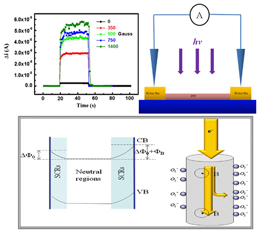強磁性ニッケル電極を用いた超高利得単一SnO2ナノワイヤー光検出器
Ultrahigh-gain single SnO2 nanowire photodetectors made with ferromagnetic nickel electrodes
2012年9月14日 NPG Asia Materials 4, e9 (2012) doi:10.1038/am.2012.48
光検出器:磁場で刺激する

国立台湾大学のYang-Fang Chenをはじめとする研究チームはこのたび、磁場を用いることで酸化スズ半導体ナノワイヤーの光応答を劇的に向上させた。酸化スズナノワイヤーは、光を照射すると、照射位置で電子-正孔対が分離して光電流を生成する。こうした効果があるため、酸化スズナノワイヤーは、ガスセンサーや太陽電池を含むさまざまなデバイスの魅力的な構成要素となっている。光応答性は、ナノワイヤーの形状や「ドーパント」の存在に依存し、一般的に電場で調節することが可能だ。研究チームは今回、電場の代わりに磁場を使うことによって、光電流を最高20倍に増幅できるシステムを考案した。このシステムでは、2つのニッケル「強磁性」電極の間に酸化スズナノワイヤーが配置されたデバイスに、磁場がかかるようになっている。ここで観測された高い光応答性は、電極の磁化によるナノワイヤー表面への電子移動に起因する。こうしたナノワイヤーと強磁性材料との組み合わせは、将来、高効率オプトエレクトロニクスデバイスの作製に役立つ可能性がある。
Photodetectors: A magnetic prod
Yang-Fang Chen and co-workers from the National Taiwan University have dramatically enhanced the photoresponse of tin oxide semiconductor nanowires using a magnetic field. Tin oxide nanowires can produce a photocurrent under irradiation through the separation of electron–hole pairs at an irradiated location — an effect that makes the nanowires attractive components for a variety of devices including gas sensors and solar cells. The photoresponse depends on the nanowires' morphology, the presence of other ‘dopant’ species, and can be typically tuned through an electric field. The researchers have now devised a system in which the photocurrent can be amplified — by up to 20 times — using a magnetic field instead. A tin oxide nanowire is placed between two nickel ‘ferromagnetic’ electrodes and the resulting device subjected to a magnetic field. The high photoresponse observed is attributed to a migration of electrons towards the surface of the nanowires, induced by the electrodes' magnetization. This combination of nanowires with ferromagnetic materials may serve in future to fabricate efficient optoelectronic devices.

